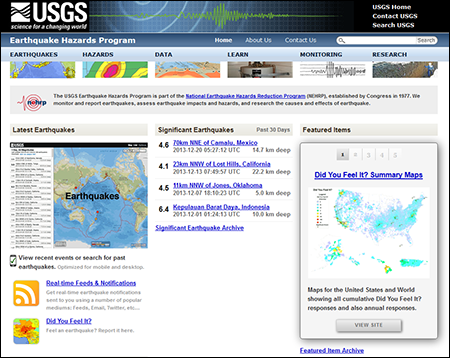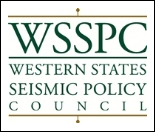Earthquake Preparedness and Response
Additional Resources

Download our Free Emergency App today!
Text GETEMERGENCY to 90999 or search "Red Cross Emergency" in the Apple App Store or Google Play Store.
Aplicación Emergencia - ahora disponible en español también!

Red Cross Ready Rating™ Program
Check out this free preparedness program to help businesses, schools and organizations evaluate and improve emergency preparedness.
- The National Earthquake Hazards Reduction Program
- United States Geological Survey
- USGS National Earthquake Center – NEIC
- Central United States Earthquake Consortium
- Western States Seismic Council
- For Workers, Employers, and General Business Resources
- For Response Worker
The National Earthquake Hazards Reduction Program (NEHRP)

The National Earthquake Hazards Reduction Program (NEHRP) was established by Congress in 1977. There are four NEHRP agencies [Federal Emergency Management Agency (FEMA), National Institute of Standards and Technology (NIST), National Science Foundation (NSF), and the United States Geological Survey (USGS)] that work in close coordination to improve the Nation's understanding of earthquake hazards and to mitigate their effects. The missions of the four agencies are complementary: The agencies work together to: improve our understanding, characterization, and assessment of hazards and vulnerabilities; improve model building codes and land use practices; reduce risks through post-earthquake investigations and education; improve design and construction techniques; improve the capacity of government at all levels and the private sector to reduce and manage earthquake risk; and accelerate the application of research results.
United States Geological Survey
The USGS Earthquake Hazards Program is part of the NEHRP, and the program is used to monitor and report earthquakes, assess earthquake impacts and hazards, and research the causes and effects of earthquake. Some of the resources on the USGS Earthquake Hazards Program site are listed below:

- Latest news on recent earthquakes
- Interactive Hazards Map
- Users sign up for real time data feeds and notifications
- Earthquake probability tool
- Earthquake archives
USGS National Earthquake Information Center - NEIC
The mission of the National Earthquake Information Center (NEIC) is to rapidly determine the location and size of all destructive earthquakes worldwide and to immediately disseminate this information to concerned national and international agencies, scientists, and the general public. The NEIC compiles and maintains an extensive, global seismic database on earthquake parameters and their effects that serves as a solid foundation for basic and applied earth science research.
Earthquake Data Available from the NEIC
Central United States Earthquake Consortium

Established in 1983 with funding support from the Federal Emergency Management Agency, Central United States Earthquake Consortium's (CUSEC) primary mission is, "... the reduction of deaths, injuries, property damage and economic losses resulting from earthquakes in the Central United States." CUSEC is a partnership of the federal government and the eight states most affected by earthquakes in the central United States. Those states are: Alabama, Arkansas, Illinois, Indiana, Kentucky, Mississippi, Missouri, and Tennessee.
CUSEC serves as a "coordinating hub" for the region, performing the critical role of coordinating the multi-state efforts of the central region. Its coordinating role is largely facilitative and not as the primary implementer of emergency management functions which is the responsibility of each individual state.
Resources on the CUSEC's website include multi-state planning events and updates, publications on earthquake safety, mitigation, planning, maps and more.
Western States Seismic Policy Council

The Western States Seismic Policy Council (WSSPC) is a regional earthquake consortium in the western states organized as a 501(c) (3) non-profit organization and is funded by the Department of Homeland Security's Federal Emergency Management Agency. It is headquartered in Sacramento, California, and the members are the State Geological Survey and Emergency Management Directors of 13 western states, 3 U.S. territories, a Canadian territory and a Canadian province, and liaisons to 7 western state seismic safety councils and commissions.
For Workers, Employers and General Business Resources:
- Induced Earthquakes Raise Chances of Damaging Shaking in 2016 United States Geological Survey. The USGS maps identify potential ground-shaking hazards from both human-induced and natural earthquakes. In the past, USGS maps only identified natural earthquake hazards.
- Preparedness Planning for your Business. Ready.gov - Federal Emergency Management Agency (FEMA). Discusses workplace emergency preparedness. Provides information on emergency program planning, implementation, testing and exercise, and improvement.
- Earthquakes. Ready.gov - Federal Emergency Management Agency (FEMA). Discusses what to do before, during and after an earthquake. Lists resources for building an earthquake kit and making an emergency plan.
- Earthquakes. Centers for Disease Control and Prevention (CDC). Discusses what to do before, during and after an earthquake.
- Earthquakes. Environmental Protection Agency (EPA). Discusses how to prepare for an earthquake, with an emphasis on water safety and security.
- Earthquake Safety Checklist. American Red Cross. Concise checklist that summarizes what to do before, during and after an earthquake.
- Power Outage Checklist | col-md-ish. American Red Cross. Concise checklist that summarizes what to do before, during and after a power outage.
- Climate Change and Occupational Safety and Health. National Institute for Occupational Safety and Health (NIOSH) Workplace Safety and Health Topic
For Response Worker(s)
- Preventing Injuries and Deaths of Fire Fighters due to Structural Collapse. U.S. Department of Health and Human Services (HHS), National Institute for Occupational Safety and Health (NIOSH) Publication No. 99-110, NIOSH Alert (1999). Summarizes incidents of fire fighter deaths and injuries due to structural collapse. Provides recommendations for minimizing structural hazards at fire fighting sites.
Indoor Environmental Pollutants
An interagency indoor environmental pollutant workgroup developed guidance for employers and workers engaged in disaster recovery operations, focusing on demolition, clean-up, and rebuilding of damaged homes. Disaster recovery workers may encounter asbestos, lead, mold and radon at their work sites. The guidance from the U.S. Department of Housing and Urban Development (HUD), the U.S. Department of Health and Human Services (HHS), the Environmental Protection Agency (EPA), and OSHA provides information about these types of hazards and how to protect workers from exposure.
- Asbestos: Worker and Employer Guide to Hazards and Recommended Controls
- Lead: Worker and Employer Guide to Hazards and Recommended Controls
- Mold: Worker and Employer Guide to Hazards and Recommended Controls
- Radon: Worker and Employer Guide to Hazards and Recommended Controls
Psychological Resilience During an Emergency Response
- Tips for Supervisors of Disaster Responders: Helping Staff Manage Stress When Returning To Work. Substance Abuse and Mental Health Services Administration (SAMHSA)
- A Guide to Managing Stress in Crisis Response Professions (2005). Substance Abuse and Mental Health Services Administration (SAMHSA). This SAMHSA pocket guide provides first responders with information on signs and symptoms of stress and offers simple, practical techniques for minimizing stress responses prior to and during a disaster response.
- Field Manual for Mental Health and Human Service Workers in Major Disasters. Substance Abuse and Mental Health Services Administration (SAMHSA)
The SAMHSA Disaster Distress Helpline is a national hotline dedicated to providing year-round immediate crisis counseling for people who are experiencing emotional distress related to any natural or human-caused disaster. This toll-free, multilingual, and confidential crisis support service is available to all residents in the United States and its territories. Stress, anxiety, and other depression-like symptoms are common reactions after a disaster. Call 1-800-985-5990 or text TalkWithUs to 66746 to connect with a trained crisis counselor.
- Disaster Responders-SAMHSA Disaster Behavioral Health Information Series Installment. Substance Abuse and Mental Health Services Administration (SAMHSA)
- Psychological First Aid for First Responders. Substance Abuse and Mental Health Services Administration (SAMHSA)
- Tips for Disaster Responders: Understanding Compassion Fatigue. Substance Abuse and Mental Health Services Administration (SAMHSA)
- A Post-Deployment Guide for Supervisors of Deployed Personnel. Substance Abuse and Mental Health Services Administration (SAMHSA)
- Introduction to Disaster Behavioral Health Webinar. Substance Abuse and Mental Health Services Administration (SAMHSA)
- Health, Safety, and Resilience for Disaster Responders. Centers for Disease Control and Prevention (CDC)
- Surviving Field Stress For First Responders. Centers for Disease Control and Prevention (CDC)
- Traumatic Incident Stress: Information for Response Workers. National Institute for Occupational Health (NIOSH), CDC
- Psychological First Aid Manual. U.S. Department of Veteran Affairs
- SAMHSA's Efforts for Disaster Preparedness, Response, and Recovery Website. SAMHSA coordinates behavioral health resources to help responders and communities prepare, respond, and recover from disasters.
- Coping with a Disaster or Traumatic Event. Centers for Disease Control and Prevention (CDC). Provides general strategies for promoting mental health and resilience that were developed by various organizations based on experiences in prior disasters.


